13
2023
-
04
Effect of the Mixer Design Parameters on the Performance of a Twin Paddle Blender: A DEM Study (2)
Keywords:
twin paddle blender,particle mixing,batch mixing
Source: internal company
3. Results and Discussion
In this section, the effects of the paddles' configurations (paddle's angle, width, and gap) on the performance of the mixing system are examined. The mixing performance, diffusivity coefficient, particles' velocity components, the total force acting on particles, and power consumption of the mixer are compared for various paddle configurations.
3.1 Mixing Performance
The selected control volume's size for RSD calculations significantly affects the RSD values. Thus, in analogy to previous studies, sensitivity analysis needs to be carried out to identify the control volume's size. To do so, the RSD values are calculated for the base simulation run (40 RPM, 40% fill level, and 0°paddle angle with TB initial loading) for different control volume sizes. Based on the results presented in Figure 6, further reductions in control volume's size smaller than 4 × dp had a negligible impact on RSD values. Accordingly, to reduce the post-processing computational time, the control volume's size of 4×dp (0.02 m) is selected for further RSD calculations in this study. Using the selected control volume's size, the system is divided into 28, 16, and 28 cube bins sequentially in the x, y, and z directions.
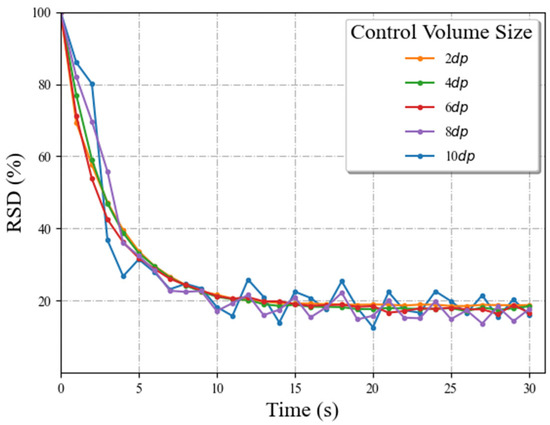
Figure 6. Sensitivity analysis for the effects of control volume size on the RSD values.
Figure 7 demonstrates the influence of paddle angle on the mixing performance. The RSD values derived from the DEM simulation versus time are depicted in Figure 7, which compares the RSD indices for four different paddle angles when the fill level is 40%, the impellers speed is 40 RPM, the paddle gap is 1 dp and the paddle width is 1 A. After a rapid initial decline, all the mixing indices eventually fluctuate around their fixed value. However, the time that they reach the steady-state condition varies for each case. As seen in Figure 7, for a paddle angle of 30°to 60°, the mixing status is significantly influenced by the paddle angle during mixing. As can be seen in Figure 7, for the top-bottom initial loading pattern with a 40% fill level and 40 RPM impeller speed, the mixer with a 60°paddle angle has the worst mixing rate compared to other cases in all mixing times. However, toward the end of the mixing time (i.e., after 25 s), the RSD values obtained from the mixer with a paddle angle of 60°finally reach the vicinity of RSD values yielded by other paddle angle cases. Moreover, increasing the paddle angle from 0°to 45°deteriorates the mixing performance at the initial stages of mixing (before 6 s when comparing 0°and 30°and before 15 s when comparing 45°with 0°and 30°). However, after 15 s of the mixing process, the mixing performances for 0°, 30°, and 45°paddle angles reach almost the same values. Figure 7 illustrates that the mixing performance (RSD) reduces monotonically with the rake angle in the range of 30–60°when paddle width and gap are held constant. Thus, increasing the paddle angle in the mixer generally lessens the system's mixing performance. However, the previously reported results showed that a better mixing performance was attained for the paddle angles of both 30°and 45°than that for a paddle angle of 0°for a single paddle blender. This difference can be explained by the fact that the mixing in the twin paddle blender is partly dependent on the movement of particles from one vessel to the other one. Thus, in a twin paddle blender, the number of particles that can be transferred between two vessels was the highest using a 0°paddle.
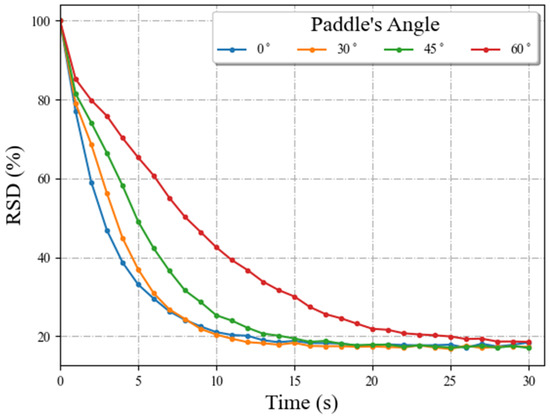
Figure 7. RSD values versus time for various paddle angles.
Figure 8 illustrates the mixing behaviors of four different impeller's blade angles at different time instants when the fill level is 40%; the impeller rotational speed is 40 RPM, the paddle gap is 1 dp, and the paddle width is 1 A. These figures show how mixing takes place over time. Initially, the red and blue particles are entirely separated. Over time, the particles are gradually mixed. After the simulation is completed, a mixture with a high mixing quality is obtained (t = 30 s). Comparing the particle distribution of four different impellers' configurations reveals some differences. Particles in the mixer with a 0°paddle angle are transported radially in the mixer by impellers (Figure 8a). However, the impellers pushed particles along the z-direction toward the shaft in other cases (Figure 8b–d). Moreover, by comparison of the simulations' snapshots (especially for the initial stages of the mixing process), it can be found that the particle distribution is more homogeneous for the mixer with a paddle angle of 0°. These results also confirm the trends that are reported in Figure 7.
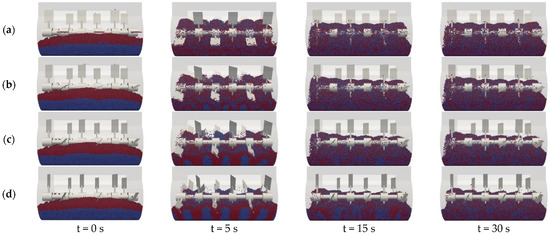
Figure 9 illustrates the variation in mixing performance when changing paddle width (RSD mixing index versus time). As can be seen, paddle width has a significant influence on the mixing efficiency. As expected, the mixing performance improved as a wider paddle was employed. However, increasing the paddle width from 1.0 A to 1.25 A did not affect the mixing index significantly. The results in Figure 9 show that the blade width in the paddle mixer is a critical parameter for achieving better mixing. This observation can be explained by the number of particles that can be touched and moved by the impellers using various paddle widths due to the difference in the paddle surface area. When 0.25 A and 0.5 A are used as the paddle width, several particles are not touched by the impellers. Thus, those parts of the particle bed cannot show a homogenous mixture, which results in an inferior mixing performance (low RSD value). Although using the narrow paddle width (0.25 A and 0.5 A) is not popular in industrial applications, in this study, we used these paddle widths to examine the impacts of paddle width on the mixing behavior of the double paddle mixer.
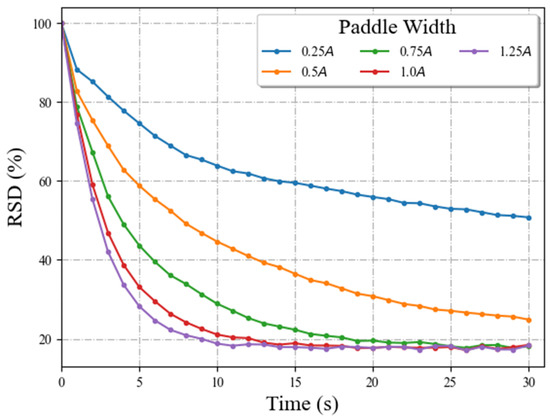
Figure 10 illustrates the RSD values calculated during the mixing process for the mixer with various paddle gaps. Various paddle gaps from 0.25 dp to 2.0 dp are considered in the simulations for a paddle angle of 0°. This figure demonstrates a negligible difference in RSD values using various paddle gaps in the system. Thus, it is concluded that the paddle gap has a minor influence on the mixing progress in the double paddle blender.
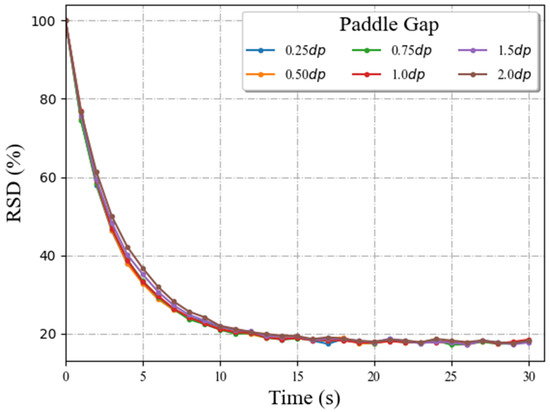
3.2 Particle Diffusivity
This section of results explores the effect of the paddle angle on diffusion in the mixing system. As observed in our previous study, the dominant mixing mechanism in the double paddle blender was diffusion. Thus, the diffusivity coefficient can be employed to compare the mixing performance for various paddle angles. As reported in the literature, the diffusivity coefficient values significantly depend on the selected time interval (Δt), as indicated in Equation. Therefore, in this study, a sensitivity analysis is conducted on the diffusivity coefficient values for various time intervals. After testing different values for Δt, the diffusivity coefficient becomes independent of Δt values, where the time interval is equal to or less than 1/4 of the impeller's revolution time. Thus, in the post-processing calculation in this study, 1/4 of the impeller's revolution time is selected for the time interval (Δt=0.375 s). Table 1 summarizes the diffusion coefficients for different simulations using various paddle angles.
Table 1. Diffusion coefficient calculated for various paddle angles (for 30 s simulation of 40% fill level and 40 RPM).
| α=0° | α=30° | α=45° | α=60° | |
| Dxx (m2/s) | 2.13 × 10−3 | 1.28 × 10−3 | 6.70 × 10−4 | 2.60 × 10−4 |
| Dyy(m2/s) | 1.82 × 10−3 | 1.21 × 10−3 | 7.30 × 10−4 | 3.56 × 10−4 |
| Dzz(m2/s) | 3.88 × 10−4 | 6.00 × 10−3 | 6.10 × 10−4 | 3.80 × 10−4 |
As shown in Table 1, the paddle angle of 60°produces the lowest values of diffusion coefficients in all directions. These results can explain the poor mixing performance obtained from 60 compared to all other impeller configurations analyzed in this research. These results also can clarify the trends reported in Figure 7 and Figure 8. Consistent with our previous study and other literature, in this study, Dxx and Dyy are higher than Dzz in all the simulation cases presented in Table 1. A higher diffusion coefficient in x and y directions indicates that mixing mainly occurs in these directions. Thus, mixing performance comparison can be performed by comparing the diffusion coefficients in x and y directions. Moreover, Table 1 reveals that diffusivity coefficients decrease in x and y directions as the paddle angles increase. This observation can confirm the RSD values' trends presented in Figure 7, in which when the paddle angles increase, the mixing efficiency decreases.
3.3 Mixing Kinetics: Velocity Distribution and Granular Temperature
Figure 11 illustrates the spatial velocity distribution of the particles. It can be seen that between two adjacent blades, most of the particles are stationary, while those near the impellers achieve relatively greater velocities. Moreover, quantitative comparisons are conducted by calculating the probability density distributions of velocity components in the x, y, and z-axis (depicted in Figure 12). Probability density distributions around zero velocity tend to be normal distributions in all directions, indicating that most particles in the mixer remain stationary. Figure 12 also reveals that more particles in the mixer with paddle angles of 60°and 45°are stationary, followed by the mixer with paddle angles of 30°and 0°. This observation is inconsistent with what is shown in Figure 11, where increases in the paddle angle increase the number of stationary particles.
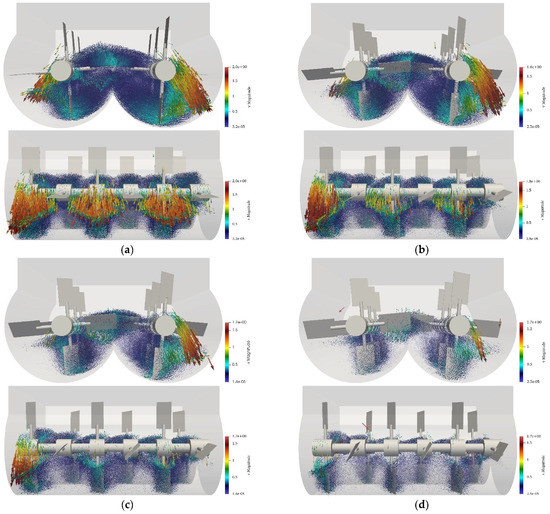 Figure 11. Spatial particles' velocity distribution at t = 30 s: (a) 0°; (b) 30°; (c) 45°; (d) 60°.
Figure 11. Spatial particles' velocity distribution at t = 30 s: (a) 0°; (b) 30°; (c) 45°; (d) 60°.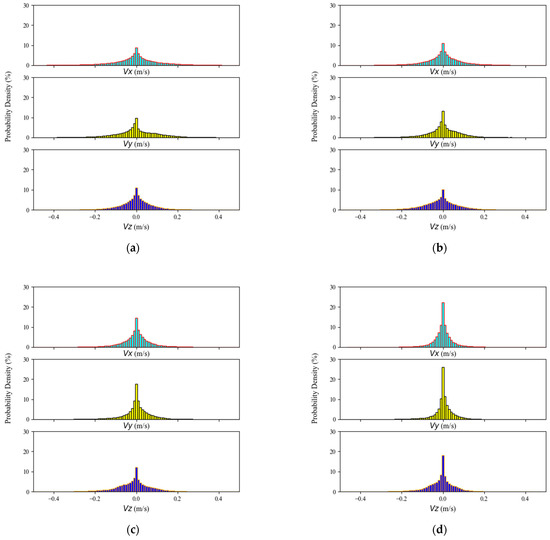 Figure 12. The probability density distributions of the x, y, and z-axis velocity components at t = 30 s for paddle angle of (a) 0°, (b) 30°, (c) 45°and (d) 60°.
Figure 12. The probability density distributions of the x, y, and z-axis velocity components at t = 30 s for paddle angle of (a) 0°, (b) 30°, (c) 45°and (d) 60°.By examining Figure 12a–d, it can be deduced that the velocity y-component for all the cases shows a right-skewed distribution, representing the direction of vertical movement of particles in all the cases. However, by increasing the paddle angle from 0°to 60°, the skew in the graphs decreases. Thus, the particles' movement in the y-direction decreases by increasing the paddle angle. Moreover, increasing the paddle angle enhances the left-skewed distribution in the z-axis, which indicates that the particles move more in the opposite of the z-direction (along the shaft). The probability distributions of the velocity x-component for the four cases are rather symmetric and near to normal distributions, showing that the probability of particle motion in the x-direction is quite the same for all cases.
Figure 13 illustrates the time-averaged granular temperature along the z-direction for various paddle angles. This figure shows that increasing the paddle angle decreases the granular temperature values, which suggests lower particle velocity fluctuations and more uniform particle flows at high paddle angles. As reported by Boonkanokwong et al., higher granular temperature values in a mixing system indicate higher diffusive mixing (particle diffusivity). Thus, the results in Figure 13 imply that a lower paddle angle in the mixing system provides a higher diffusive mixing of particles. These findings are consistent with the results presented in Section 3.2. These results can also explain the findings in Section 3.1, where a lower paddle angle intensified the particles' chaotic motion, consequently improving mixing efficiency (lower RSD values). Figure 13 also demonstrates that for all the paddle angles, there are five minimum granular temperature regions and six sections with high granular temperatures. The minimum granular temperatures occur in the regions between the paddle blades, and the sections with high granular temperatures represent the areas swept by six paddle blades. Ebrahimi et al. and Golshan et al. also reported greater granular temperatures near the impeller when studying a single paddle blender and a Nauta batch blender, respectively.
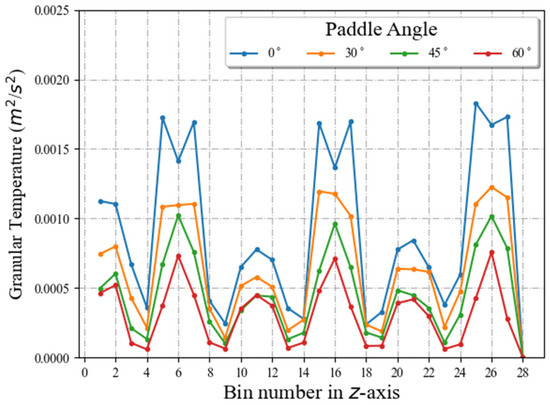
3.4 Forces Acting on Particles and the Mixer Power Consumption
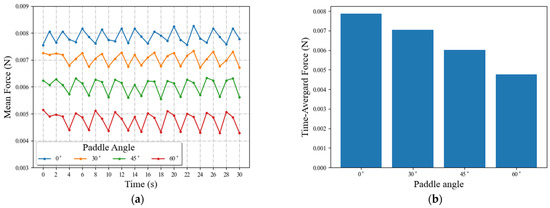
Therefore, compared to a paddle angle of 0°, when the 30°, 45°, or 60°paddle angles are used, the number of particles lifted is much lower, and particles raised from the mixture drop quickly onto the surface of the particle bed. As a result, less force is applied to the particles in these configurations than at a paddle angle of 0°. Almost no or very few particles are raised from the particle bed when the mixer paddle angle of 60°is used, which explains the minimum force obtained for this configuration. This section quantifies the forces acting on particles as a function of the paddle angle for the double paddle blender. Thus, this is an important conclusion for a mixing system containing brittle materials such as fragile crystals to maintain the integrity of particles by using high paddle angles.
It should be noticed that, in the literature, the mean force reported was spatially averaged over all the contacts in the mixture. Using the results reported in the literature, it may not be possible to identify the regions with the highest forces acting on particles. Thus, in this study, a more refined analysis is reported in order to evaluate the profile of forces acting on particles. Figure 15 and Figure 16 illustrate the forces acting on particles over the line and plane depicted in Figure 5. Figure 15 shows a variation of the time-averaged forces acting on particles in different bins in the z-direction for various paddle angles. As seen in this figure, it can be concluded that increasing the paddle angle decreases the time-averaged forces acting on particles (as reported in Figure 14). Furthermore, the fluctuations can be attributed to the movement of paddles in the particle bed. Figure 16 illustrates the contour of time-averaged forces acting on particles for various paddle angles. Near the blade tip, particles have maximum forces in all of these contours. There is a minimum force in the center of the impeller shaft, while the maximum force is around 0.08–0.16 N at the tip of the blades.
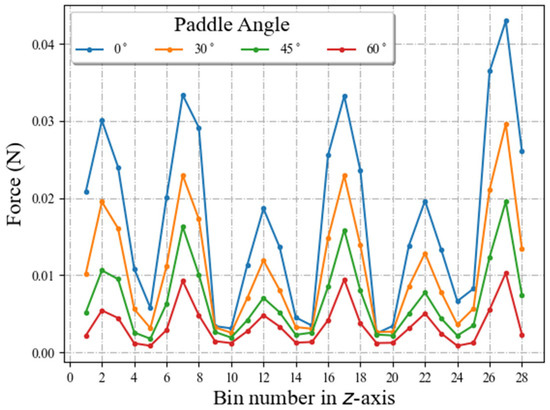
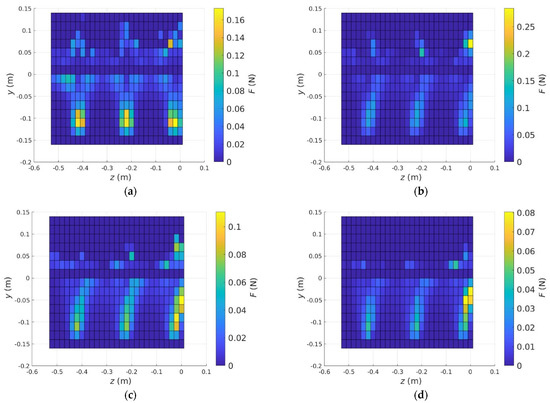
The effects of paddle angle are also examined on the system's power consumption. Figure 17 depicts the power consumption of the mixer for various paddle angles. Due to the impellers' rotation, and changes in the torque acting on impellers, the power consumption in the system fluctuated during the mixing process. Thus, the mean power consumption is calculated to compare the power consumption for different paddle angles. As shown in Figure 17a, the power consumption for the mixer with a paddle angle of 0–45°is relatively the same. However, the lowest power consumption is achieved for the mixer equipped with a paddle angle of 60°. It is important to note that the mean force described in the paper pertains to the force exerted on particles resulting from particle–particle and particle–wall interactions and is not to be confused with the mean force acting on the impellers. The latter has a direct impact on the torque and power consumption of the mixer. Therefore, it is crucial to differentiate between the two forces in order to accurately analyze and interpret the findings presented in the paper.
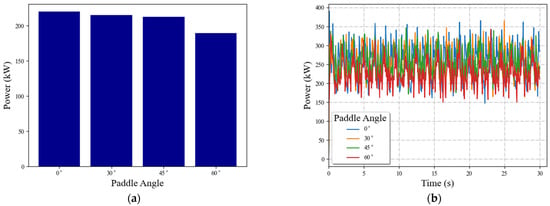
To examine the effect of the paddle width on powder mixing, forces acting on particles are compared by changing the paddle width (0.25, 0.5, 0.75, 1.0, and 1.25 A). Figure 18 and Figure 19 demonstrate that increasing the paddle width increases the time-averaged force acting on the particles. It also can be concluded that the existing bumps in the figure indicate the contact of the impeller's paddle with the particulate flow. The effect of paddle width on the force magnitude acting on particles on a plane along the mixer's shaft can be seen in Figure 20. Thus, by increasing the paddle width, the difference in force magnitude increases in the depicted profile, representing that the forces acting on particles are increased. Based on the results reported in the previous section, the highest mixing rate is achieved using paddles with a large width. However, the forces acting on the particles are increased by using the large paddle width. As mentioned earlier, in industrial applications containing brittle materials, it is necessary to maintain the integrity of the particles by optimizing the forces acting on particles. Consequently, although the blade width of 1.25 A obtains the fastest mixing rate, it may not be appropriate for mixing brittle materials.
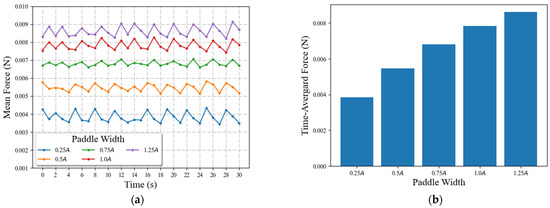
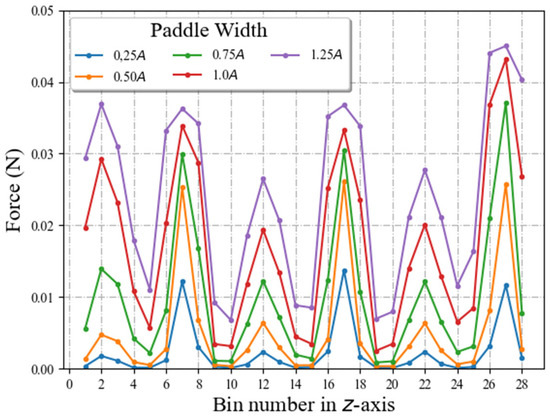
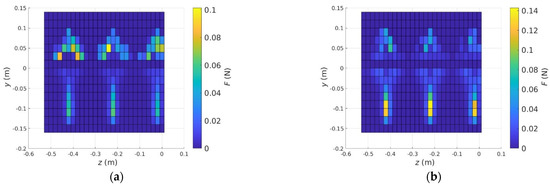
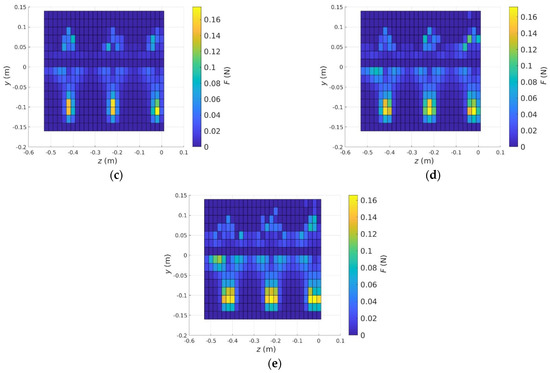 Figure 20. Contour of time-averaged forces acting on particles for various paddle width of (a) 0.25 A, (b) 0.5 A, (c) 0.75 A, (d) 1.0 A, and (e) 1.25 A.
Figure 20. Contour of time-averaged forces acting on particles for various paddle width of (a) 0.25 A, (b) 0.5 A, (c) 0.75 A, (d) 1.0 A, and (e) 1.25 A.
Figure 21a,b illustrate the impacts of the impeller's paddle width on the mean and transient power consumption of the mixer, respectively. These figures demonstrate that increasing the paddle width led to the enhancement of the system's power consumption. The paddle with 1.25 A has the highest power consumption. Since the mixing rate for the paddle width = 0.75 A is similar to those of higher paddle width (as shown in Figure 9), it can be concluded that the optimum paddle width considering both mixing time and power consumption, should be the paddle blender with a 0.75 A (0.0398 m).
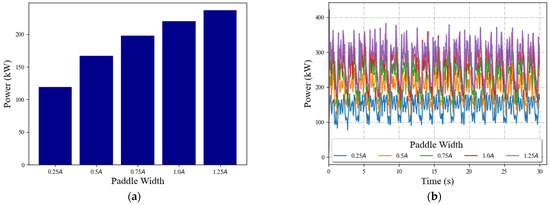 Figure 21. Power consumption of the mixer in various paddle widths: (a) mean power consumption and (b) transient power consumption.
Figure 21. Power consumption of the mixer in various paddle widths: (a) mean power consumption and (b) transient power consumption.
Figure 22 shows the time-averaged forces acting on particles for different impeller paddle gaps. The time-averaged forces acting on particles differ slightly with changing the paddle gap. However, the results indicate that the mixer with a paddle gap of 2.0 dp imposes slightly less force on particles compared to other paddle gap cases. Furthermore, it can be seen that forces acting on particles reach a maximum value in the mixer with a paddle gap of 0.75 dp. Following the results presented in Figure 22, the mean power consumption of the mixing system with a paddle gap of 2.0 dp has a minimum value and a paddle gap of 0.75 dp resulted in the highest system power consumption value, followed by 0.5 dp and 0.25 dp as shown in Figure 23.
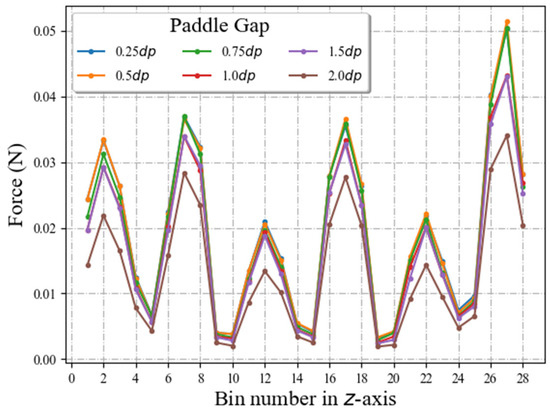
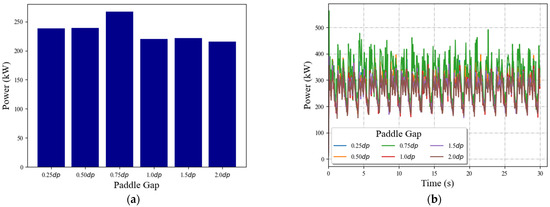 Figure 23. Power consumption of the mixer with various paddle gaps: (a) mean power consumption and (b) transient power consumption.
Figure 23. Power consumption of the mixer with various paddle gaps: (a) mean power consumption and (b) transient power consumption.
As shown in Figure 22 and Figure 23, changing the paddle gap slightly changes the mean force acting on particles and the mixer power consumption. This can be explained by the fact that some of the particles are trapped between the tip of the paddle and the mixer's wall during the rotation of the impellers when using paddle gaps smaller than 1.0 dp. As mentioned earlier in Section 3.1, mixing performance is not affected by changing the paddle gap. Thus, the optimum selection for the paddle gap would be the one that provides the minimum power consumption (2.0 dp).
4. Conclusions
In this paper, the DEM simulations were performed to examine the particle blending in a twin paddle blender containing cohesion-less, mono-disperse spherical particles. The developed DEM model in our previous research was employed to investigate the influences of the impeller configurations (paddle's angle, gap, and width) on the performance of the mixer. In order to characterize the mixer's performance, RSD values were calculated in each case.
Simulation results indicated that the performance was affected by the paddle's angle and the paddle's width. However, the latter had a more significant effect on the performance of the mixer than the former one. The RSD values of different configurations obtained from simulations revealed that increasing the paddle's angle and decreasing the paddle's width resulted in declining in mixing performance (greater RSD). Generally, the best and second-best mixing performances were achieved for the paddle angle of 30°and 0°, respectively. This was due to the fact that 30°and 0°paddle angles provided the largest and second-largest Dxx and Dyy. On the other hand, the paddle's gap had a minor influence on the mixing performance in the twin paddle blender.
The analysis of the particles' spatial velocity distribution and probability density distributions of velocity components in the x, y, and z-axis disclosed that the paddle's angle mainly influenced the velocity distributions in the y and z axis. An increase in the paddle's angle increased the number of stationary particles in the system. Analysis of the forces acting on particles and the system power consumption revealed that in comparison with a paddle angle of 0°, when the paddle angles of 30°, 45°, and 60°were used, the number of lifted particles by the impellers was much lower, and these particles dropped quickly on the particle bed surface. Consequently, the angled paddles exerted smaller forces on particles than the paddle angle of 0°. Increasing the paddle width increased the time-averaged force acting on the particles. In addition, due to the enhancement of the paddle's surface area, the system's power consumption was enhanced by increasing the paddle width. The forces acting on particles and the system power consumption varied slightly with changing the paddle's gap.
Finally, it can be concluded that the mixing behavior of the double paddle blender was significantly influenced by the impeller geometry and can be optimized by changing the design parameters of the mixer. Moreover, it was indicated that the DEM approach could be employed as a useful tool to efficiently design powder blenders. However, to expand the knowledge of particle mixing in a powder blender, the effect of particle shape and material on the mixing behavior in such a blender also needs to be investigated.
Jadidi, B., Ebrahimi, M., & Lohi, A. Effect of the Mixer Design Parameters on the Performance of a Twin Paddle Blender: A DEM Study. Processes, 11(3), 733. https://doi.org/10.3390/pr11030733
© 2023 by the authors. Licensee MDPI, Basel, Switzerland. This article is an open access article distributed under the terms and conditions of the Creative Commons Attribution (CC BY) license (https://creativecommons.org/licenses/by/4.0/).
Related news
2024-06-13

